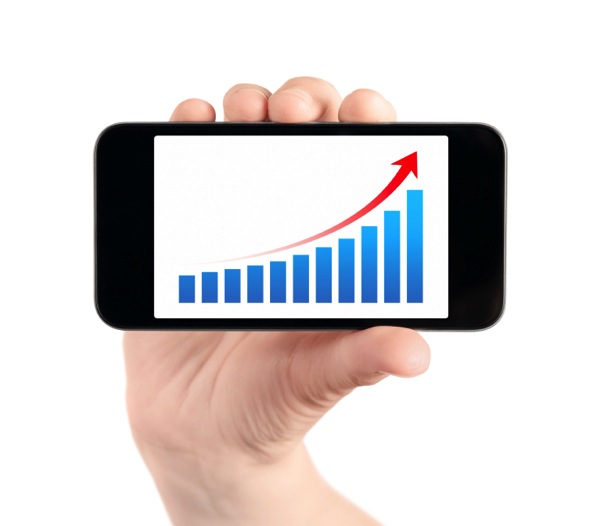How do we use Smartphones? What can we learn from usage statistics to grow our mobile event app adoption and usage rates? This article gives you data driven tactics to grow the uptake of mobile app for events.
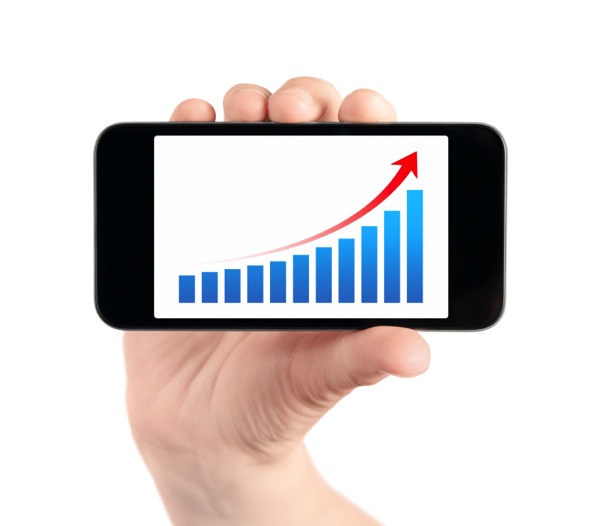
The Event App Bible experience was quite enlightening in terms of what event professionals want when it gets to mobile apps for events.
With almost 5,000 downloads and overwhelmingly positive feedback, our ebook has delivered more clarity about the event app ecosystem. Yet I like to look at it as a great tool for those that want to start with apps.
I believe our event mobile app report is the first step, then you are faced with other burning questions such as
If you invested time and/or money in choosing and setting up a mobile app for your event, you should now ensure that this investment is repaid by a strong and healthy uptake.
This post gives you some data driven tactics to skyrocket adoption and usage rates.
Your Mobile Strategy
Before we start delving into tactics, I want to reinforce a premise. It is the same basic assumption you will find in The Event App Bible.
A sound mobile strategy is a key requirement of a successful app program. You can choose the fanciest app or be a marketing genius but without a strong strategy, your chances to succeed are extremely low.
Wrong focus, audience disconnect, low internal buy-in and weak workflow will in fact affect the way your app is perceived, adopted and in the end used.
Therefore I am going to make two heavy assumptions, that you read The Event App Bible and that you have worked out a strong mobile strategy.
Defining Success
Let me ask you a question. What does success look like?
Do you know what a good uptake of your app could be?
Unfortunately there is no universal answer to these questions. Every event is different, every audience is different. Moreover, there is very little research that quantifies a successful adoption rate.
Benchmarking against competitors could be a starting point if you have no previous experience, but I would also concentrate on qualitative feedback (feedback forms, social media mentions, stakeholders engagement).
The crucial step is to try. I always suggest to start small then invest more. Running a small program could help you identifying your success metrics.
Say you’ve invested x time and y budget and obtained z result (adoption rate + usage) the first year you’ve deployed your event app, you’ve found the most important benchmark for next year’s program.
Increasing z means success, as well keeping z the same with decreased time and budget invested.
Finding out your metrics is a necessary first step to decide whether a program has been successful or not.
That said, there are plenty of data and tactics to help you pushing adoption and use even higher. Let’s have a look.
Some Stats
I’ve played around with Our Mobile Planet, a terrific portal set up by Google that gives insights in regards to mobile usage in key geographic regions around the world.
I’ve selected USA, UK, Japan and Australia as markets that may interest the average reader of this blog. I’ve also kept general demographics. You are more than welcome to head to the site and check statistical relevance for your target audience.
The objective of showing the following graphs is to give some substance behind certain app promotion tactics.
Why? – Because the last thing you want is to follow the latest buzz or self proclaimed event technology expert. It is too risky to jeopardise your time and budget this way.
Location of Smartphone Usage
The first chart shows where we tend to use smartphones more:
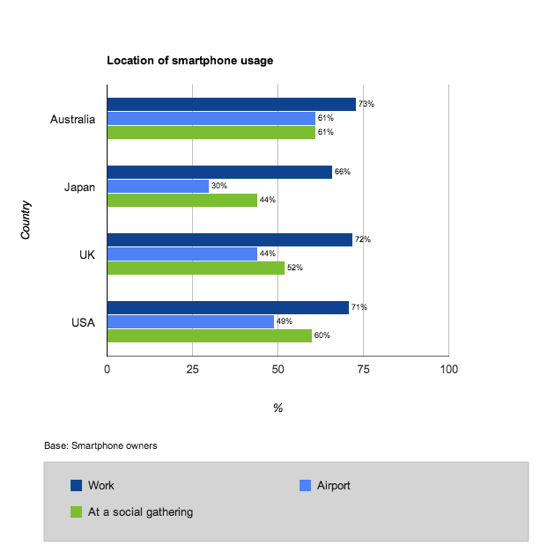
An interesting insight is that we tend to use our smartphones more when we are at work. I was surprised to find out that the use at airports is actually less than at social gatherings (i.e. events).
The usual event attendee lifecycle for marketing communications would involve:
Being at Work-> Travel to the Event-> Attend the event -> Travel Back
The stats above give us quite a hint in how we should communicate our app. More on this later.
Why We Use the Internet on Smartphones
The second graph is about general reasons why we use smartphones.
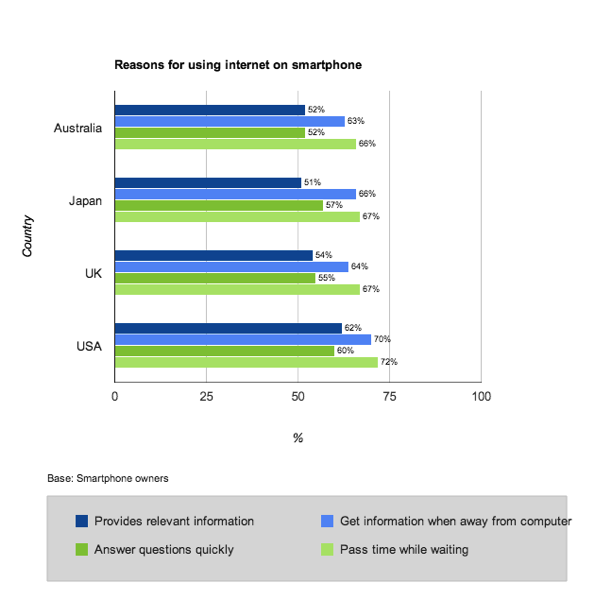
Consistently we tend to use our smartphone more while we wait. This dominant trend gives us clear indications in regards to the app content choices and promotion strategy.
General Activities We Perform with Our Smartphones
This graph is a general perspective on what actions we perform more with our smartphones.
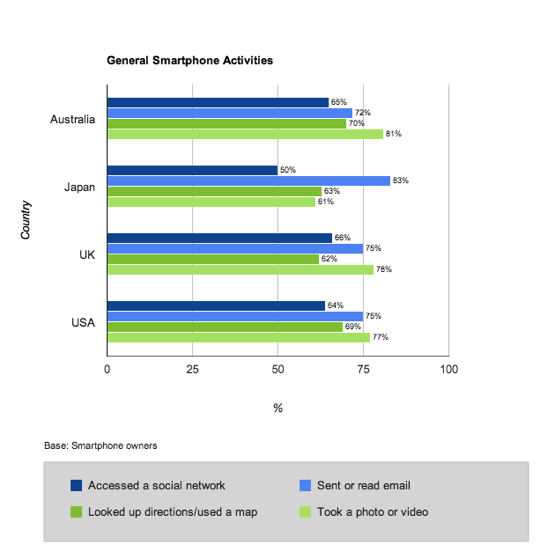
Taking pictures and sending emails seem to be the most dominant activities we perform with our smartphones. Once again there are implications that will affect our app promotion strategy.
Fostering Adoption
Getting attendees to download or access your app is what I would define as adoption. I’ll differentiate that from usage, which refers to the percentage of attendees that used the app after downloading or accessing it.
A general comment is that the graphs above scream for you to align your communication strategy and to incorporate the message that your event has an app at every communication touch point.
If we tend to use our smartphones more at work, it is highly likely that your attendees will be more prone to download or access your app while preparing to come at your event.
Your pre-event email communications should heavily promote the app as you actually have a larger opportunity to increase adoption rates.
Social
Attendees increasingly follow event social accounts. Therefore it is extremely important to communicate the existence of an app with your social networking handles.
Accessing social networks is also a widely popular activity we perform with our smartphones.
As a result, getting the tip about your event app on Twitter while I am checking it on my smartphone could lead to a smoother ‘in-device’ transition to my App Store or Google Play Store where I will then download your app or to bookmark it in my mobile browser for future reference.
At Registration
Communicating your event app while attendees are checking in or registering seems like a wise move.
If in fact the predominant use of smartphones happens ‘while we wait’ there is no better moment than registration to take advantage of this pattern. Registration in fact usually means waiting, no matter how fast your registration process is.
In this perspective informing attendees of your app via QR Codes or signage seems like a smart move.
For Apple users there is an interesting upcoming feature in iOS7 called ‘Apps Near Me’ that suggests relevant apps in the vicinity based on location. We don’t know yet the dynamics of this recommendation but it is highly likely that we can invite attendees in the future to check their ‘Near Me’ tab on the App Store to quickly download the app.
Wifi
Having a strong wifi and communicating it timely to your attendees could make or break your event app program and heavily impact on the latter tactic.
If you are in fact stimulating the attendees to check out your app but they need to rely solely on their data plan, you are missing out on the bigger opportunity to involve those with low data plans or those travelling from abroad.
If you run large events is also likely that data networks will be congested and that will surely impact on the number of attendees able to download or access your app.
Fostering Usage
I am going to talk now about how we get those who access your app to actually use it during the event.
The three graphs we’ve looked at earlier give in fact a strong indication of the activities we may perform to drive usage figures high.
Smart Notifications
Another strong reason why we use the internet on our smartphones is to obtain relevant information.
Notifications offer a great way to send relevant information to your attendees in a timely fashion. Telling your attendees that a session is starting or what is happening next fall within this relevancy spectrum.
A great reason to use your app.
Strong Schedule and Content
We use smartphones to get answers quickly.
Filling in your app with as much relevant information as possible is key to get attendees to use it.
A complete schedule/programme will immediately generate that feeling of ‘usefulness’ that will move attendees to use the app more during the event.
Maps and FloorPlans
We use smartphones to get answers and look up directions on maps. The Map/Floorplan section of an event app essentially combines these two activities.
The directions component could be a great selling point to get attendees to download your app to begin with.
Therefore make sure you properly communicate the presence of maps and that the information in the app is correct.
Opening Remarks
Using housekeeping moments to foster event app adoption seems to be also a smart move. In fact an opening session is usually a waiting time separating the average attendee from getting the education or the networking she paid for.
Telling your audience how the app can help to achieve their objectives during these session can actually get people to both download and use the app.
Reinforcing the message that there is an app and that it is being used, while giving some statistics, seems like a good idea.
Emphasis on Social
Inviting your attendees to use the app to carry out their social networking activities during the event is also a winning move.
Social networking is very popular when it gets to using our smartphone.
Getting your attendees to tweet or update their status on Facebook from the app therefore sounds like a powerful tactic to get attendees to use the app more.
Photo Competitions
Taking photos or videos is a quite popular activity among smartphone users. Capitalising on this opportunity is paramount to ensure a higher uptake of your event mobile app.
A photo or video competition taken through the app could be a great tactic to get attendees to download and use your app more during the event.
In Conclusion
Making sure that your event mobile app program succeed is a quite stimulating challenge. It requires a sound mobile strategy and clear definition of what success looks like.
There are powerful tactics to increase adoption and usage of your event app. These tactics are based on statistical use of smartphones that creates a fundamental prerequisite to validate the effectiveness of the advice found in the article.
Once again, each event is a unique mix of audience and strategy so make sure to do your homework before trying any of the above. The Event App Bible is a great starting point.
